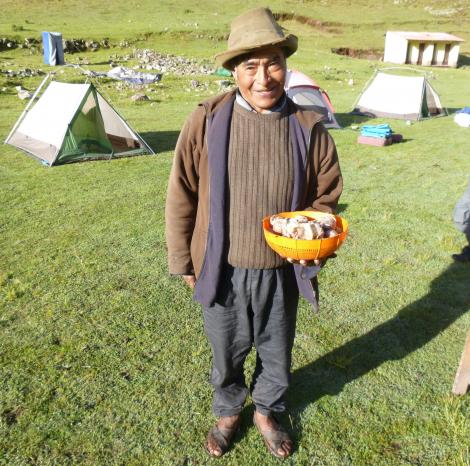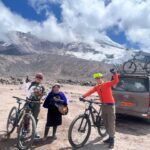Nutrition at altitude – how local crops can help
 by Kathy Jarvis on 29th August, 2014
by Kathy Jarvis on 29th August, 2014

Nutrition at altitude
This week our guest blogger and expert nutritionist, Dr Chris Fenn, shares with us some tips on how to get the most from Peru’s native crops when at altitude.
Chris writes:
Whilst eating good quality foods for general health is important, there are several key nutrients associated with high altitude acclimatisation. As the pressure of oxygen in the air decreases, EPO (erythropoietin) protein is released by your kidneys to stimulate extra red blood cell production in your bone marrow.The nutrients associated with red blood cell production (at high or low altitudes) are protein, vitamin E and the B vitamins folic acid, B 12, and B 6. These are involved with new cell production, whilst the mineral iron is part of the haemoglobin molecule found at the centre of each red blood cell.
Red meat and green veg
Red meats such as beef, pork and lamb are plentiful in the high Andes, and these provide B vitamins and the most readily available form of iron. Iron found in plant foods is more difficult to absorb, but iron absorption can be improved if you eat foods which contain vitamin C in the same meal. Most green vegetables and fruits will provide some vitamin C.
Land of potatoes
Potatoes are not particularly rich in vitamin C, but are eaten at almost every meal in villages around Peru and so can contribute a significant amount. There are over 200 varieties of potato – look out for the purple and blue ones.
Quinoa to keep you going
Another staple, which is wonderfully nutritious, is quinoa (pronounce “keen-o-wah”). This is a seed rather than a true cereal, like wheat, oats or barley. Unlike these cereals it is a protein powerhouse, as well as providing the all important iron.
Quinoa is also a rich source of calcium, magnesium and potassium – which help with muscle function as you trek up to the higher villages.Provided that you drink enough water, these minerals can also help to prevent muscle cramp.
Quinoa has a long history in Bolivia and Peru and over 120 varieties are known but the yellow, red or black seeds are the most common. Vitamin E is found in the germ of the seed and since makes up about 60% of the seed, quinoa has plenty of vitamin E.
A wheat grain, by comparison, has only 3% germ. With its high ratio of protein to carbohydrate, quinoa is a fabulous food to take with you. As a dry seed, it is easy to carry and easy to cook.
Simply boil, like rice, in plenty of water until the grains are swollen and soft. Add plenty of leafy vegetables and you have a perfect meal. Quinoa flour and flakes are common and there is a huge range of products, including breakfast cereals and drinks, made from quinoa.
However it is best to eat this ancient food as close as possible to its natural state.
Try Amaranth
Another crop native to Peru is Amaranth. Like quinoa, it is a seed rather than a true cereal. Again it is high in protein, iron, magnesium and calcium. Surprisingly it also contains some vitamin C – which will help with iron absorption. Amaranth is sold on the streets of Peru, often popped like corn. It is also a traditional ingredient for porridge and the flour is used in bread, muffins and pancakes. Like quinoa, amaranth is naturally gluten free. Gluten is a protein found mainly in wheat, barley and rye. More and more people suffer from a definite immune reaction to gluten, known as coeliac disease, and must avoid eating it. Others find that they simply feel better if they keep gluten out of their diet.
If you based your eating habits on local foods such as potatoes, quinoa, amaranth and fruits rather than gluten containing cereals, you may find that you return from your travels feeling better than before!
To find out more about your nutrition and get more useful tips, drop Chris an email on eat4success@chrisfenn.com
and visit her website www.chrisfenn.com .
Contact us for more.
Share







